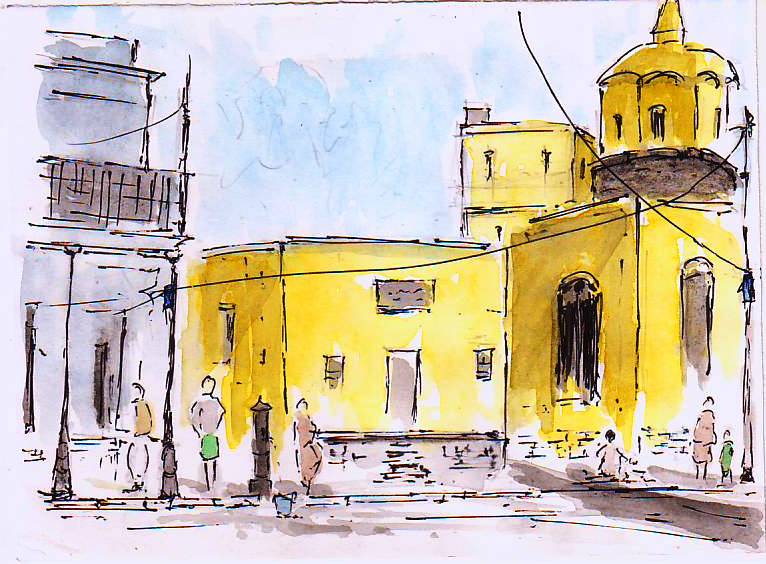Of Porticoes and Public Water Taps
This line and wash sketch is inspired by an old photograph of Keshab Chandra Sen’s Bharatvarshiyo Brahma Mandir at 95 Keashab Chandra Sen Street in north Calcutta. It is also known as the Navabidhan Brahma Samaj. This is the Brahma shrine where Swami Vivekananda acted on stage with Keshab Chandra Sen in Troilokyanath Sanyal’s play Navavrindavan. The photograph, much older than me, was a reminder of something that may appear insignificant to many. But it is such an integral part of my childhood, an age when we absorb every sight, sound and smell with an intensity we fail to retain as we age, that I can hardly disown it.
What struck me was not a part of the main architectural interest here but the front portico of an adjacent house only partially revealed in the photograph. The portico covers the entire footpath (sidewalk) as they always did. A view of this open porch, built over an iron structure supported at regular intervals by iron pillars, takes me back to my schooldays when on my way to school, I would walk beneath several such porticoes in Calcutta’s Beadon Street. They sheltered me when it suddenly began to rain. How often did I stand in their cool shade and had a chat with a school friend! Didn’t I even feel a little jealous of the inhabitants of those noble mansions, the aristocrats of yesteryears, who could enjoy all day, sitting on those wide verandas, a full view of the road?
The shape, size and construction of the iron pillars on which the porticoes stood mesmerized me. They were wider at the base with intricate patterns on them but gradually tapered as they went up. I knew it for certain that those large houses were built for ever but I didn’t know then that those porticoes of my childhood would gradually disappear, like so many people I used to know, into thin air. I couldn’t foresee then that as the city will embrace ‘modernity’, the small joys of my childhood would disappear completely.
The other object that caught my attention in that photograph is the public water tap on the footpath. They were solid stumps of iron with a crown at the top. What an elaborate construction for as simple a device as a water-tap, I used to think! Such an object helps you to peek into the times they were made and the mind of the people who made them. Those public water taps appeared invincible and indestructible — made to last longer than human civilization. I still remember the sensation of touching their cool body and drinking water from them using only my hands and mouth. How would I know then that one day even those water taps will fade into oblivion?
Read More

















Recent Comments